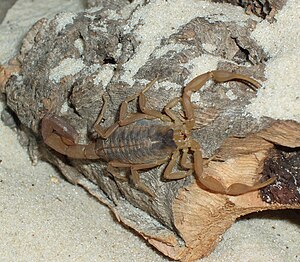Arizona bark scorpion
| Arizona bark scorpion | ||||||||||||
|---|---|---|---|---|---|---|---|---|---|---|---|---|

Centruroides vittatus |
||||||||||||
| Systematics | ||||||||||||
|
||||||||||||
| Scientific name | ||||||||||||
| Centruroides vittatus | ||||||||||||
| Say , 1821 |
The Arizona bark scorpion ( Centruroides vittatus ), also known as the small Texas scorpion , belongs to the family of Buthidae . It is a small to medium-sized scorpion with a size of about 7 cm in adults. The color ranges from dark to very pale shapes. The drought-loving xerian forms are more yellowish, whereas the mesian (neither drought- nor moisture-loving) forms have a rather darker basic color and the stripes turn slightly orange. From the outside, the C. vittatus is very similar to the C. exilicauda , but can be distinguished by a triangular, mostly dark “mask” between the median pair of eyes on the carapace , which is missing in C. exilicauda .
habitat
The habitat of C. vittatus extends from the whole of Texas over parts of the neighboring states to northern Mexico. The scorpion hardly stops in built-up areas, which is why it can be seen more often in and around residential buildings. The scorpion mainly hangs in crevices in the rock or bark, where he usually spends the day hanging upside down and also eats his food.
toxicity
The Centruroides vittatus belongs to the less poisonous scorpions, although it belongs to the genus of the otherwise poisonous and medically important Centruroides . Under normal physical conditions (healthy, non-allergic, etc.), the symptoms of a sting are similar to those of a bee sting.
The insectivorous grasshopper mouse Onychomys torridus (a rodent ), which prey also includes scorpions, has a glycoprotein that is activated by a component of the toxin . The pain-causing effect is blocked, which gives a conditional resistance to the toxin.
behavior
The C. vittatus is nocturnal, but is rarely found during the day. In the adult stage it behaves quite neutrally towards other adult scorpions of its own kind, younger scorpions, however, can be regarded as food. Otherwise it has a rather low cannibalism rate.
Lining
The range of prey includes all animals in the habitat of the appropriate size that can be overwhelmed.
swell
- Günther Schmidt: Poisonous and dangerous arachnids in the world . Westarp Sciences Publishing Company, 2000.
- Alexander Tietz: Biology, husbandry and reproduction of the Arizona bark scorpion . In: Terraria , No. 1, Sep./Oct. 2006.
- David H. Desorr: Scorpions of Texas . In: Arachne - the specialist magazine for arachnids , ISSN 1613-2688 .
Web links
Individual evidence
- ↑ Ashlee H. Rowe, Matthew P. Rowe: Physiological resistance of grasshopper mice (Onychomys spp.) To Arizona bark scorpion (Centruroides exilicauda) venom. In: Toxicon . Volume 52, No. 5, 2008, pp. 597-605.
- ↑ Daniel Lingenhöhl: A grasshopper mouse knows no pain . In: Spektrum , January 14, 2013, accessed February 24, 2016.